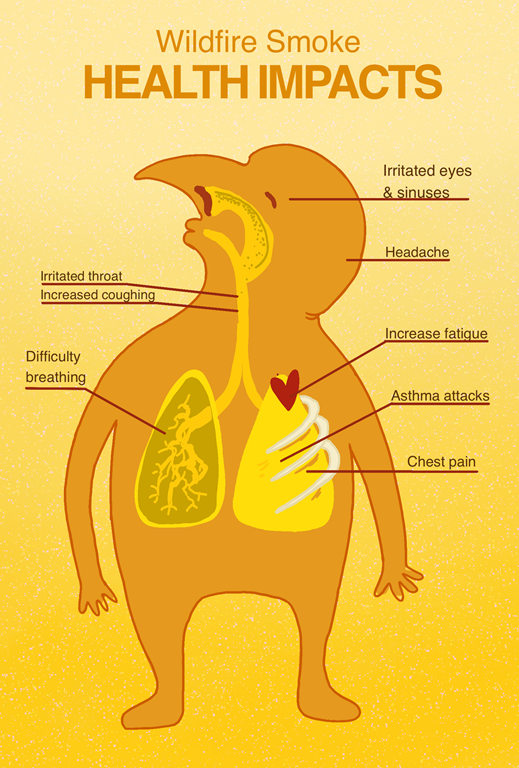With summer now upon us, many British Columbians are seeking to embrace the sun and make the most of the warm weather — before it begins to rain for another nine months. Unfortunately, this time of the year often coincides with the height of wildfire season here in B.C. and in most of North America. While we may want to spend as much of our time outside as we possibly can — appreciating all of the outdoor activities and natural wonders this province has to offer — it’s also important to be mindful of environmental conditions and take care of our respiratory health.
According to Health Canada, from 2013 to 2018, up to 2500 premature deaths per year were associated with long-term exposure to wildfire smoke. Beyond that, there is research to suggest that said exposure can also lead to a higher risk of certain cancers, as well as the risk of heart attacks.
So, how do we balance the joys of summer with the suffocating pall of smoke that threatens our forests as much as our lungs?
The Cascade reached out to UFV kinesiology professor Dr. Luisa Giles for her insight on the matter. Much of her PhD research focuses on this area of concern: the effects pollution and environmental factors can have on cardio-respiratory health.
Air pollution poses a number of risk factors for our overall health, especially relating to our respiratory and cardiovascular systems. When asked what components in wildfire smoke can specifically cause harm, Giles explained, “Wildfire smoke contains a mixture of air pollutants such as particulate matter, carbon dioxide, water vapor, carbon monoxide, hydrocarbons, and nitrogen oxides. In wildfire smoke, particulate matter, in particular fine particulate matter known as PM2.5 (and also ultrafine particles), is the primary air pollutant of concern for health.” This particulate matter, when inhaled, irritates the airways and can cause a wide array of short-term and long-term problems.
While the primary health concerns are those relating more directly with the lungs and other parts of our respiratory system, once pollutants enter the bloodstream, further complications can occur. “In the short term (e.g., over a few days),” Giles said, “we know that exposure to wildfire smoke can exacerbate respiratory and cardiovascular illnesses. It can also cause a sore throat, eye irritation, runny nose, coughing, wheezing, phlegm production, and headaches. In some people it may cause difficulty breathing, chest pain, dizziness, heart palpitations, and impair lung function.”
The possibility of health complications is of concern to everyone; however, air pollution and wildfire smoke particles can present an even greater threat to specific at-risk demographics. According to Giles, these demographics include, “those with chronic health conditions, especially those with respiratory conditions such as COPD and asthma, also those with heart disease, diabetes, or cancer may be at an increased risk.” She also noted that “pregnant people, children, and the elderly” can face higher risks when outdoors under poor air quality conditions.
With all that said, what do experts recommend for those who want to keep active during the summer? The general consensus seems to be that the best course of action when dealing with low air quality is simply to stay indoors as much as possible, especially when considering high-intensity activities. Minimizing the amount of polluted air and smoke particulates inhaled is the most reliable way to protect your respiratory health. Giles also recommended — if using indoor facilities to stay active — to keep windows closed and to use HEPA filters, a high efficiency air purifying system used to remove fine particles from the air within indoor spaces. “If the windows are open,” Giles said, “or there isn’t a HEPA filter, then it could be very similar to exercising outside.”
Giles also suggested referring to the Air Quality Health Index (AQHI) when planning outdoor activities. The AQHI can be found on the Government of Canada website and is a useful resource when assessing air quality and safe activity levels. It provides air quality information by location, including possible health concerns and recommended actions based on air quality for both the general population and those within at-risk groups.
Of course, all this isn’t to say that we need to avoid outdoor activities entirely. I’m not here to scare anyone away from enjoying their summer and spending time outside in the limited amount of sun we’re gifted along the west coast of B.C. Take advantage of good weather and clear conditions! Just try to avoid spending too much time outdoors when the air quality is poor, whether you are being physically active or not. Stay safe out there!
Elyssa is a BSc student, pursuing studies in Physical Geography while also entertaining her creative side within the visual arts. She is currently the Creative Director here with the Cascade. Having previously been an Illustrator, Production Assistant, and Production Manager, she's been around a while. In her free time she can often be found knitting and watching reruns of outdated shows from the 80s.


